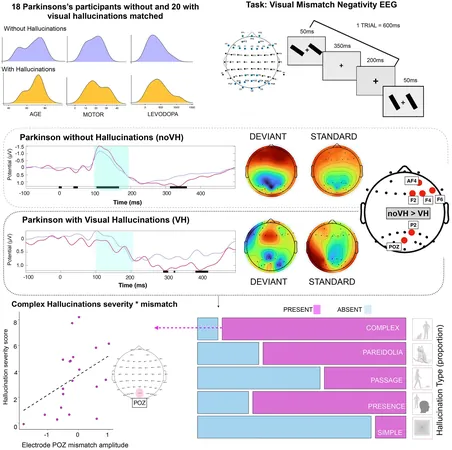
Groundbreaking Discovery Links Visual Mismatch Negativity to Parkinson's Disease Psychosis!
2024-10-01
Groundbreaking Discovery Links Visual Mismatch Negativity to Parkinson's Disease Psychosis!
In a compelling new study, researchers from the Institute of Psychiatry, Psychology & Neuroscience (IoPPN) have identified decreased brain activity in response to unexpected visual changes as a significant marker for psychosis in Parkinson’s disease (PD). This research, published in the esteemed journal Brain Communications, highlights visual mismatch negativity (vMMN) as a promising therapeutic target for managing this debilitating condition.
Psychosis, particularly in the form of visual hallucinations, is one of the most perplexing non-motor symptoms affecting nearly 40% of those diagnosed with Parkinson's. The onset of these hallucinations often begins subtly, with patients reporting minor sensations such as the feeling of an uninvited presence, which can escalate to vivid visual disturbances and delusions over time. These experiences severely impact quality of life for patients and their loved ones.
Historically, the emergence of psychotic symptoms in Parkinson’s patients has been linked to the long-term use of dopaminergic medications. However, this recent investigation reveals that visual hallucinations can occur independently of such treatments, affecting even those who have never taken Parkinson's drugs. This raises crucial questions about the underlying biological mechanisms driving these symptoms.
In the study, 20 PD patients experiencing visual hallucinations were subjected to electroencephalography (EEG), allowing researchers to monitor their brain activity in reaction to visual stimuli. These participants were compared with a control group of 18 PD patients who did not experience hallucinations. During the test, participants were instructed to focus on a central cross on a screen, pressing a button when they noticed any size changes, while ignoring surrounding unexpected visual prompts known to trigger vMMN.
The results were telling: individuals with Parkinson’s and visual hallucinations exhibited reduced vMMN in specific brain regions. Moreover, a direct correlation was found between the severity of visual hallucinations and the extent of vMMN reduction—providing credible evidence that vMMN could serve as a reliable psychosis marker in Parkinson’s patients.
Miriam Vignando, a Research Fellow and lead author, emphasized the significance of their findings. "By confirming that visual mismatch negativity is a strong indicator of psychosis in Parkinson's disease, we can better map the variability in experiences among individuals with this condition," she stated. "This understanding is crucial for those living with Parkinson's and their families."
In addition to exploring vMMN, the research delved into the serotonergic pathway's role in visual hallucinations. Emerging evidence suggests that modulation of this pathway can reduce hallucinations, with tests showing effectiveness in both healthy subjects and Parkinson's patients. This new insight indicates that targeting the serotonergic system may be a viable avenue for creating therapeutic solutions for individuals suffering from motor and non-motor symptoms of PD.
“Parkinson's disease psychosis remains an area needing extensive research. There are limited effective treatments, and these hallucinations can signify a worse overall prognosis, including an increased risk for dementia,” stated Mitul Mehta, Professor of Neuroimaging & Psychopharmacology and senior author of the study. He draws parallels between Parkinson’s-related psychosis and psychotic symptoms seen in conditions like schizophrenia, underscoring the importance of understanding these connections.
This groundbreaking discovery not only enhances our understanding of Parkinson's disease psychosis but also opens new pathways for targeted treatment strategies, offering hope to millions affected by this challenging condition. Keep an eye on this research—it's paving the way for a clearer future for Parkinson's patients everywhere!


 Brasil (PT)
Brasil (PT)
 Canada (EN)
Canada (EN)
 Chile (ES)
Chile (ES)
 España (ES)
España (ES)
 France (FR)
France (FR)
 Hong Kong (EN)
Hong Kong (EN)
 Italia (IT)
Italia (IT)
 日本 (JA)
日本 (JA)
 Magyarország (HU)
Magyarország (HU)
 Norge (NO)
Norge (NO)
 Polska (PL)
Polska (PL)
 Schweiz (DE)
Schweiz (DE)
 Singapore (EN)
Singapore (EN)
 Sverige (SV)
Sverige (SV)
 Suomi (FI)
Suomi (FI)
 Türkiye (TR)
Türkiye (TR)